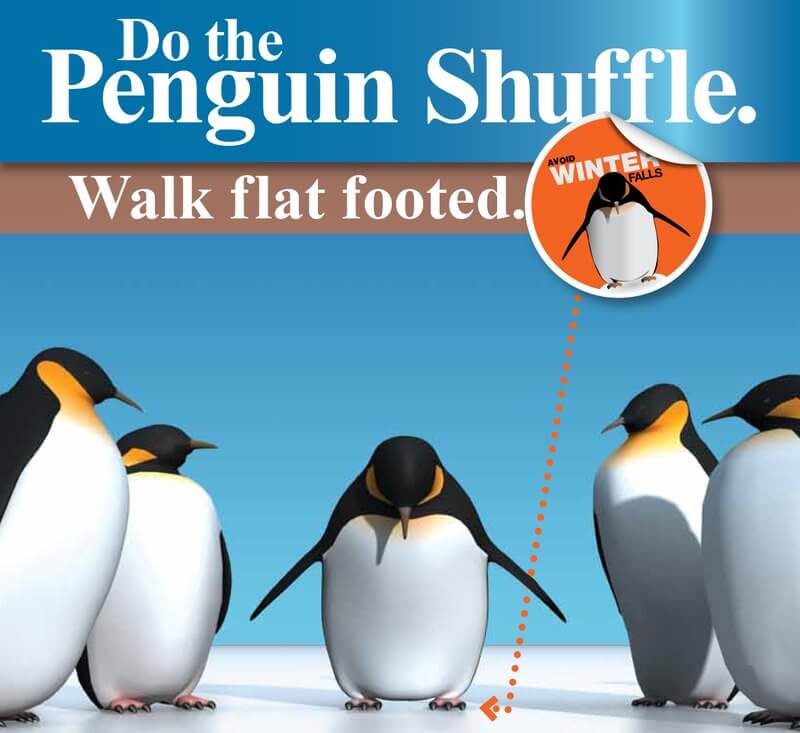Preventing falls on slippery walkways and roads
The Penguin Shuffle
Avoid winter slips and falls by doing the Penguin Shuffle! It's a great way to maximize the amount of contact between your feet and the ground.
Here's how to do it:
- Focus on getting from point A to point B safely.
- Take shorter, slower, flat steps (like a penguin).
- Keep your head up and don't lean forward.
- Concentrate on maintaining balance.
Winter in Minnesota is a wonderful time, especially for those who enjoy outdoor activities. But a few safety precautions can keep you safe and reduce your risk of falling and suffering injuries on the ice and snow.
- Allow yourself extra time. Walking too quickly on a slippery sidewalk can lead to a fall.
- Stretch often and keep muscles flexible. Cold weather makes muscles less elastic.
- Invest in shoes and boots with good traction. There also are traction pieces that can be attached to shoes.
- Walk with a “shuffle” on icy walkways.
- Be focused. Look out for black ice, wet leaves, icy stairs, etc.
- Be cautious and use assistance, such as holding someone’s hand or railings, if they are available.
- Practice strength training and balance exercises if your health allows. A strong, steady body is more likely to respond and be able to prevent a fall. Great options are the classes Stepping On, A Matter of Balance and Tai Ji Quan: Moving for Better Balance offered through the Central Minnesota Council on Aging. Learn more at www.cmcoa.org or at 320-253-9349.
- Keep a container of salt and/or sand in your garage or near doors to sprinkle on driveways and sidewalks to reduce snow and ice. Consider keeping one in your car too, to sprinkle around your vehicle if parking in an icy lot.
- Keep a small flashlight you can keep in your purse or coat pocket. Minnesota winters get dark early in the evening and extend later into the morning. Having a light can help you watch your step for when the sun goes down.
- Do not hesitate to ask for help from family or neighbors to assist with clearing walkways after a snowfall.
For extra protection, consider the following products to help you or a loved one stay safe:
- Ergonomic support handles to provide support when getting out of a vehicle.
- Traction cleats that fit over your shoes and boots for walking on snow or ice.
- Tips to provide extra grip for canes, walkers and crutches.
The holidays also can present situations which may cause falls or injuries:
- Keep stairs well-lit and free from obstacles. Clutter, alcohol and fatigue are factors that increase the risk of a fall from stairs.
- Be aware of tripping hazards. Decorations, presents under the tree, pets and small children at get-togethers are all potential tripping hazards to watch out for during the holiday season.
- Use appropriate step ladders so you can comfortably reach when hanging lights or decorating tree branches.
What do I watch for if I fall?
Did you know that falls are the most common cause of traumatic brain injuries (TBIs)? Not only that, but people 75 years of age and older have the highest rates of TBI-related hospitalizations and deaths. This is yet another reason why it is important to take precautions to prevent falls, especially when it comes to winter weather. While it is important to be educated on how to prevent falls, it also is important to know what to do in the event a fall does occur.
Symptoms of a mild head injury include:
- Persistent low grade headache
- Trouble concentrating, remembering things, making decisions and solving problems
- Feeling tired and lacking energy or motivation
- Change in sleep patterns
- Increased sensitivity to light and sound
- Loss of taste or smell
- Ringing in ears
- Mood changes
Symptoms of a moderate or severe head injury include:
- Persistent or worsening headache
- Repeated nausea or vomiting
- Convulsions or seizures
- Inability to wake up from sleep
- Dilation of one or both pupils
- Slurred speech
- Weakness or numbness in arms or legs
- Loss of coordination
- Increased confusion, restlessness or agitation
If you have any of the above symptoms see your provider immediately. If you or your loved one is on blood thinners (such as Warfarin), you should see a health care provider for any bump or blow to the head — even if symptoms are not present. Do not hesitate to seek medical attention; your chances for recovery are best if you are treated right away!
Call 320-255-7265 to schedule a free home safety assessment by the Central Minnesota Falls Prevention and Home Safety Coalition.
